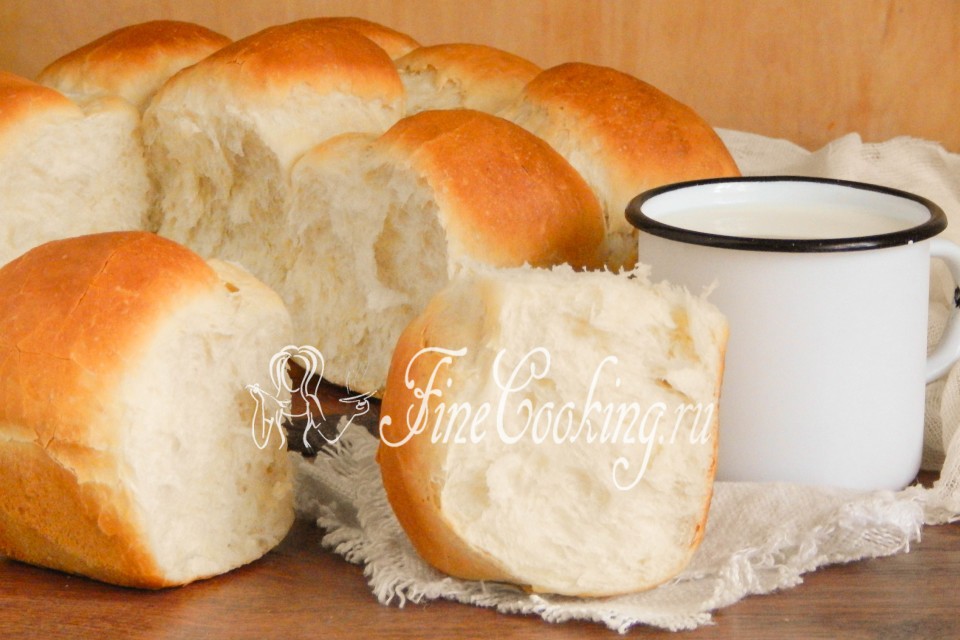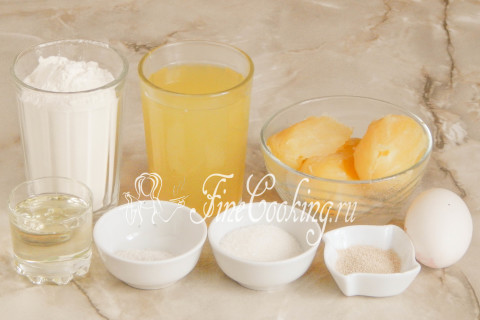Step 1
To prepare fragrant, delicate and airy potato buns, we need the following ingredients: wheat flour (I have the highest grade, but the first one is suitable), a potato decoction and boiled potatoes, a raw chicken egg, a refined vegetation (I use sunflower) oil, salt, sugar and high -speed yeast. By the way, if you want to make this recipe for baking buns in a lean version, just replace the chicken egg of about 45-50 milliliters of water or potato decoction. The yeast is not necessary to take fast -acting ones — just dry (also 5 grams is a teaspoon with a slide) or pressed (3 times more, that is 15 grams). Such yeast is not immediately mixed with flour, but previously activated in a warm sweetish liquid for 10-15 minutes. In our case, you can slightly heat half a glass of potato broth with a tablespoon of sugar and dissolve the yeast in it.
Step 2
Sift (preferably twice) wheat flour in a bowl. Due to this, the flour is not only loosened and saturated with oxygen, but possible garbage will also leave. Add fast yeast, granulated sugar and salt to flour. Mix everything thoroughly with a fork or a whisk.
Step 3
In another bowl (in which we will knead the dough for potato buns), connect a raw chicken egg (medium -sized) and boiled potatoes, which we previously turn into a puree mass.
Step 4
We add a slightly warm potato broth and 1 tablespoon of refined vegetable oil there. All this must be combined in a single homogeneous mixture, for which it is most convenient to use a submersible blender. You can also make it a whisk or even a fork.
Step 5
The result is airy and magnificent liquid mass.
Step 6
Pour to her pre -sifted and mixed with yeast, sugar and salt wheat flour. You can not all at once, but in parts, if you don’t know how the flour behaves — it can be wet or dry.
Step 7
First, you can mix the ingredients with a spoon or fork so that the flour is moistened, absorbing the liquid. And you want, you can immediately knead the dough with your hands. If there is a test or bread maker, be sure to use their help — this is easier and faster.
Step 8
To knead the dough for potato buns for quite some time (at least 10, and better than 15 minutes) and intensively. As a result, it will become smooth, homogeneous, very soft (like an earlobe) and delicate, while a little sticky. We round the dough into the ball and put it in a bowl, which we grease with a tablespoon of vegetable oil so that it does not stick to the dishes during fermentation. We send the dough to heat for 1 hour, after which we make a light degree, re -rounding and again in heat for another 40 minutes. Where is it better to wander the test and what does a warm place mean? There are several options. First of all, in the oven with a light bulb turned on (it turns out about 28-30 degrees — the temperature ideal for fermentation of yeast dough). Then we tighten the bowl with the dough with cling film or cover with a towel made of natural fabric (flax is best suited) so that the surface does not be swollen and not covered with a crust. You can also let the dough wander in a microwave, in which we pre -boil a glass of water. The dough will rise with a door closed, and the glass will stand there. Then the bowl does not need to be closed with anything, since the water will evaporate, thereby maintaining the necessary humidity. Just make sure that no one inadvertently turns on the microwave, otherwise the dough will disappear and there will be no potato buns.
Step 9
After 1 hour 40 minutes (time — the concept of relative, it may take more or less) yeast dough for potato buns will rise very well, and will increase by three times exactly. It is very tender and fluffy. If the dough rises weakly, then you came across old yeast — increase the time of fermentation.
Step 10
Divide the dough into pieces of the same size — I have 9 pieces (according to the size of the baking dish). By the way, buns can be baked not only in shape, but also directly on a baking sheet. Why is it so important that the buns to be the same size? First of all, they will need the same amount of time both for proof and baking. Well, and the aesthetic side is important — ready -made homemade buns will be all as for selection (if a stove on a baking sheet).
Step 11
The molding of potato buns is very simple and straightforward. Sprinkle a piece of the dough with wheat flour so that it is not linked to the hands. Then, with your palm, we beat off the dough several times into a cake to remove excess air — in the finished buns, there are useless pores. If you have little experience in working with yeast dough and the molding of the blanks takes a lot of time, cover the rest of the dough dough with cling film so that they do not be swollen and not covered with a crust.
Step 12
Now round the workpiece — pull the dough from the edges to the center, pressing with your fingers so that it does not spread back.
Step 13
We chop the seam well so that the workpieces do not deform during the proofing process.
Step 14
We turn the ball of dough with a seam down and round the future buns. It is quite difficult for me to show the process without video, but I will try to describe. We squeeze the work palm, spreading our fingers, as if holding a large orange. Cover the workpiece with the palm in this position and begin to rotate the dough ball counterclockwise. Everything happens easily and effortlessly, while we, as it were, slightly bend the dough inward with 4 fingers, but without pressure.
Step 15
Thus, we roll up all 9 blanks for buns. They turn out so neat and smooth. We shift the bunks in the baking dish (lubricate it very little with refined vegetable oil) or on a baking sheet covered with baking paper. We cover the workpieces with a light towel made of natural fabric or cling film. We leave in a warm place for 35-40 minutes.
Step 16
When the blanks grow up well and increase in volume at least twice, they still bake them. Before planting in the oven, you can sprinkle them with water (my version), grease with milk or egg yolk.
Step 17
We bake potato buns in a preheated oven at an average level at 180-185 degrees. Baking time varies from 30 to 45 minutes (depending on the size of the workpieces). My buns spent 35 minutes in the oven. They were slightly torn from the sides — this drawback due to the fact that I did not give the workpieces to the end. But this does not affect in any way.
Step 18
Ready -made ruddy potato buns should cool, best on the grill (so that condensation is not going to the bottom).
Step 19
But, of course, it is the most tasty to eat homemade yeast pastries still warm, although it is impossible. Try it, you will definitely like these chubby, air and very delicate potato buns!



















